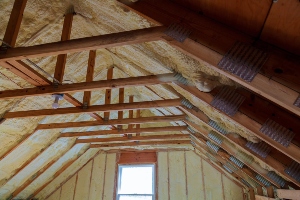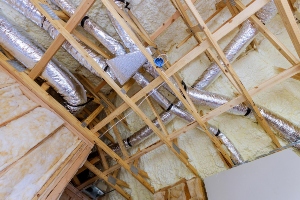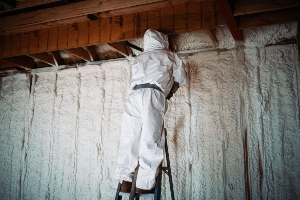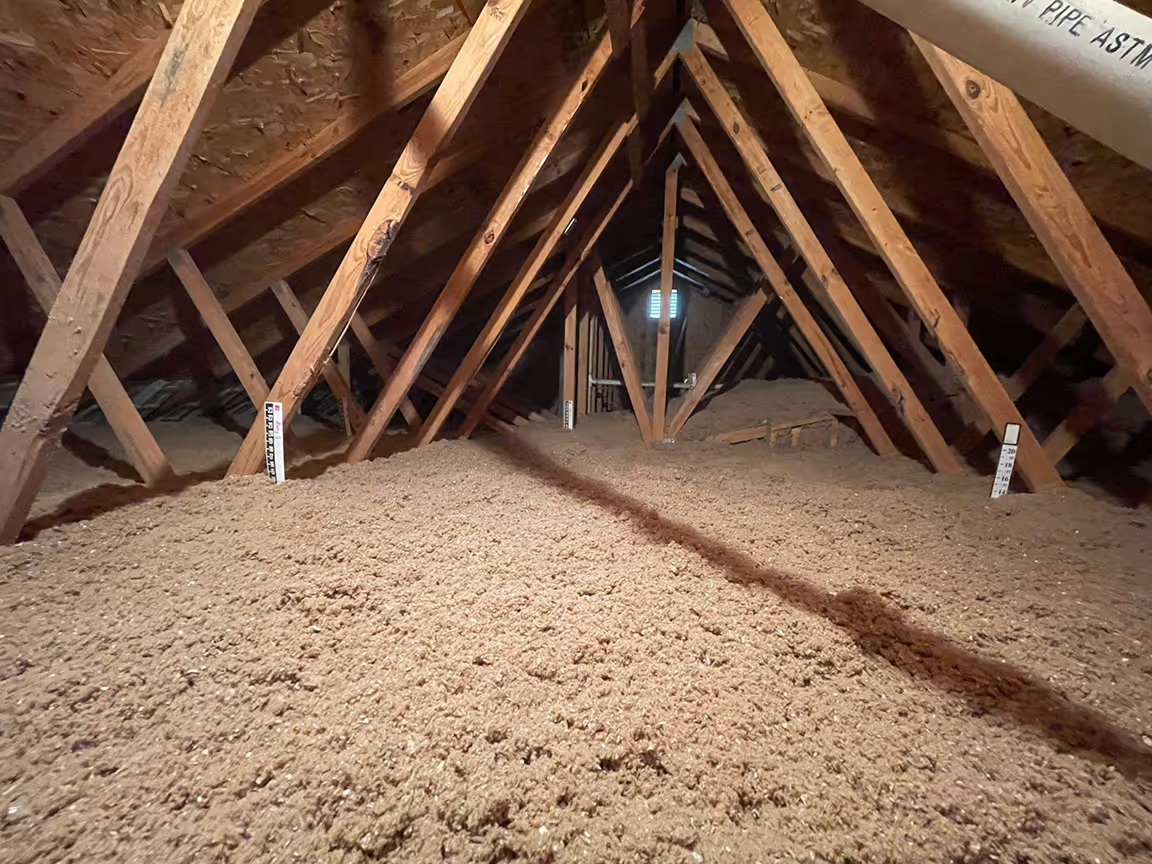Insulation is one of the most effective ways to create an energy-efficient home. When properly installed, it creates a barrier that keeps heat inside during winter months and outside during summer. This simple home improvement can dramatically reduce energy costs while making your living space more comfortable year-round.
Properly insulating your home reduces heating and cooling costs and creates a more comfortable living environment by maintaining steady indoor temperatures. Many homeowners don’t realize that up to 40% of their energy costs come from heat loss or gain through walls, floors, and ceilings that aren’t properly insulated.
Good insulation works alongside proper air sealing to create a complete thermal envelope around your living space. This protective barrier is essential for energy efficiency and is key for preventing moisture issues that can damage your home over time.
Understanding Insulation and Energy Efficiency
Insulation works by trapping air within materials that slow the movement of heat, creating a more stable and comfortable indoor environment while reducing energy consumption.
The Science of Insulation and Heat Transfer
Heat naturally flows from warmer to cooler areas through three main processes: conduction, convection, and radiation. Insulation works by creating barriers to these heat transfer methods.
- Conduction occurs when heat travels directly through materials. Insulation materials contain millions of tiny air pockets that slow this transfer.
- Convection happens when air circulates and carries heat away. Proper insulation prevents air movement between walls and attics.
- Radiation transfers heat through electromagnetic waves, which certain reflective insulation types can block.
Factors Affecting Insulation Efficiency
Several key factors determine how well insulation performs in real-world conditions. Installation quality is perhaps the most crucial, as even small gaps can reduce efficiency by 25% or more. Moisture is another enemy of effective insulation because when insulation gets wet, its effectiveness drops significantly. Proper vapor barriers and ventilation help prevent this problem.
R-values measure the effectiveness of insulation, and higher values mean better insulation. Homes in extreme temperature regions require higher R-values than moderate climates. The Department of Energy recommends different minimum R-values based on geographic location.
Age and compression of insulation also affect performance. Over time, some materials settle or compress, reducing their effectiveness. Regular inspection can identify when replacement or additional insulation is needed.
Types of Insulation Materials
Different insulation materials offer varying benefits for specific applications and budgets.
- Fiberglass insulation remains the most common type, available as batts, rolls, or loose-fill. It’s relatively inexpensive but can irritate skin and lungs during installation. R-value: 2.2-3.8 per inch.
- Cellulose insulation consists of recycled paper products treated with fire retardants. It’s environmentally friendly and fits well in irregular spaces. R-value: 3.2-3.8 per inch.
- Spray foam insulation comes in open-cell or closed-cell varieties. It creates an excellent air barrier and provides high R-values, especially closed-cell foam at 6.0-7.0 per inch.
Other options include:
- Mineral wool (R-value: 3.0-3.3)
- Rigid foam boards (R-value: 3.8-6.5)
- Reflective/radiant barriers (most effective in hot climates)
Insulation and Overall Home Energy Performance
Proper insulation works as part of a whole-home energy system, and when combined with efficient windows, doors, and HVAC equipment, insulation delivers maximum benefits. The impact on energy bills can be substantial. Well-insulated homes typically use 30-50% less energy for heating and cooling than poorly insulated ones. This translates to lower utility costs and reduced environmental impact.
Insulation also helps HVAC systems work more efficiently, as when less heat escapes in winter or enters in summer, heating and cooling equipment runs less frequently and lasts longer. Temperature fluctuations also decrease in well-insulated spaces, creating more comfortable living conditions and eliminating cold spots or overheated areas. Indoor air quality improves, too, since proper insulation reduces drafts that can carry dust and allergens.
Implementing Effective Insulation Strategies
Proper insulation implementation requires a systematic approach that addresses air leaks, evaluates existing materials, and targets specific areas of the home. The right strategy can dramatically reduce energy costs while improving comfort throughout the year.
Detecting and Sealing Air Leaks
Finding and fixing air leaks is the first step toward an energy-efficient home, as even the best insulation works poorly if air freely flows around it. The first step should be to conduct a home energy audit to identify drafts and leaks. Common leak locations include windows, doors, electrical outlets, and where different building materials meet. Use a smoke pencil or incense stick on a windy day to detect air movement, or look for cobwebs, which often indicate air currents.
Sealing techniques vary by location. Use weatherstripping for movable components like doors and windows, and apply caulk for stationary cracks smaller than ¼ inch. Larger gaps may require expanding foam sealants. Don’t overlook hidden leaks in attics, basements, and around plumbing penetrations. These often contribute significantly to energy loss despite being out of sight.
Evaluating and Upgrading Existing Insulation
Check the R-value (thermal resistance) of existing materials and compare it to recommended levels for your climate zone. Then, look for signs of insulation problems: cold spots on walls, high energy bills, or rooms that never seem comfortable. Compressed, wet, or moldy insulation needs immediate replacement as it loses effectiveness. When upgrading, consider working with an insulation contractor for complex areas, as they can recommend appropriate materials based on your specific needs and climate conditions.
Insulation Solutions for Specific Home Areas
Different areas of your home require tailored insulation approaches. In attics, 16-20 inches of insulation (R-49 to R-60) is required in most climates. However, it’s important to ensure proper ventilation to prevent moisture buildup. Walls typically need insulation with good moisture resistance, especially in bathrooms and kitchens. For existing homes, blown-in insulation can fill wall cavities without major reconstruction.
Don’t neglect floors over crawl spaces or unheated basements. Insulating these areas can eliminate cold floors and improve overall comfort. Combine insulation with a moisture barrier in crawl spaces to prevent dampness. Rim joists (where your house sits on the foundation) are often overlooked but critical for preventing drafts. Seal these areas with rigid foam board cut to size and sealed with caulk.
Maximizing Energy Savings and Comfort
Proper insulation strategies balance insulation needs with other home systems and take advantage of available financial incentives.
Balancing Insulation and Ventilation
While insulation traps heat, proper ventilation prevents moisture buildup and maintains air quality. The attic requires special attention, and insulation with high R-values reduces heating costs, but adequate ventilation prevents ice dams in winter and excessive heat buildup in summer.
Install bathroom and kitchen exhaust fans that vent to the outside, as these remove humid air that could otherwise cause mold growth within insulated areas. Also, consider mechanical ventilation systems like heat recovery ventilators (HRVs) that exchange stale indoor air with fresh outdoor air while retaining most of the indoor temperature. This maintains energy efficiency while improving air quality.
Preventing Common Insulation Problems
Install vapor barriers on the warm side of insulation to prevent condensation that can reduce effectiveness and cause structural damage. Avoid compression of loose-fill or batt insulation, too. Compressed insulation loses R-value and creates cold spots that increase heating and cooling costs.
Common insulation issues to watch for:
- Gaps around electrical outlets and fixtures
- Settling of loose-fill insulation over time
- Thermal bridging through wall studs
- Inadequate coverage in hard-to-reach areas
Professional insulation contractors can use thermal imaging to identify problem areas where energy waste occurs. This targeted approach often delivers the best return on investment.
Incentives for Energy-Efficient Insulation Upgrades
Federal tax credits can significantly offset the cost of insulation improvements, and currently, homeowners can claim up to 30% of insulation material costs through energy efficiency tax incentives. Many utility companies also offer rebates for insulation upgrades that meet specific R-value requirements. Contact your local provider to learn about available programs.
State and local governments often provide additional incentives through energy efficiency programs. These may include low-interest loans or direct rebates. The energy savings from proper insulation typically pay for the investment within 3-5 years. Homes with optimal insulation can reduce utility bills by 15-30% annually.
Get in touch to arrange an energy audit to assess your insulation needs.





